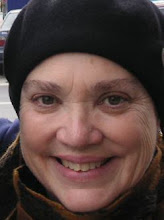A little over a year ago, I was asked to give a lecture on new directions in felting. I had been making felt for around 35 years at that point, and to tell the truth, I had become pretty obsessed with my own directions in felt. (I developed a technique for making photo realistic pictures in felt that I called "Watercolor Felt" and I have been making pictorial felts with this method for several years.) I was not really aware of what had been going on around the world in my field since I was so absorbed in this relatively small aspect of feltmaking. When I began doing research to see what was "new", I was very surprised. New materials, new methods, new looks to the felt- lots of new things! I was excited by these new approaches to making felt and I decided that I wanted to start learning as much as I could about them. Until recently, I always understood how a felt product was made, but with these new felts, I was flummoxed. I decided the best way to learn about them was to take as many classes as I could in the USA from teachers who I perceived to be experts in their approach to making felt. In the past year, I have taken classes from Pam deGroot (Australia), Rod Welch and Karolina Arovilimmi (Finland), Vilte Kazlauskaite (Lithuania), Irit Dulman (Israel), Tash Wesp (USA), Loyce Ericson (USA) and Leiko Uchiyama (Japan and Ireland). All of these wonderful teachers have had workshops close enough to my home in Oregon that I could travel to them. In addition to these workshops, I have been studying from online tutorials and books. It is really amazing what I've learned!
For instance:
1. People are really understanding and exploiting the properties of wool to make interesting things happen in feltmaking. The ruffles along the edge of this scarf are an example of this. I learned how to do this from a tutorial I purchased from Irene Rudman (Israel) of Rudman Art. The technique makes use of the fact that wool will shrink in the direction of its root. The wool in the center of the scarf was placed so that its roots were lying in the opposite direction of the fibers laid around the edge. When the center shrank, the outside edge didn't so it was "gathered" into ruffles. Very cool!


2. Another thing I learned is that really deep, wonderful textures can be created and will hold together in a felt if they are felted to a base cloth using superfine merino wool as the felt "glue". This is the first time I had used 3 mm silk chiffon (the base cloth) and 19 micron merino in this way. Vilte taught us the relief techniques using silk cloth and various fibers, including flax and silk. However in these pictures below, I am exploring the textures with cotton gauze and voile.
Above: Sample of cotton fabric flower and pleat textures.
My friend Kathe Todd-Hooker with the textured felt scarf I made her for her birthday.
The scarf in process. Notice that the flowers and other textures are face down. The base cloth and "glue wool" will be put over the top of these textures.
More another day on this learning adventure of mine.
_________________________________________________________













.jpg)













